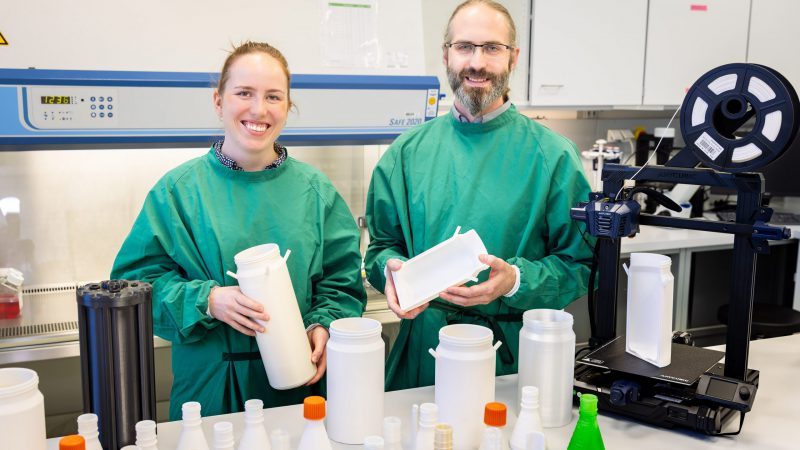Author: Martin Walpot, acib GmbH
Viennese acib and BOKU researchers are developing a sterile 3D printing process that can be used to produce laboratory equipment from environmentally friendly and biodegradable plastic. This could avoid several million tons of single-use plastic waste and reduce resource, energy and water consumption by up to 90 percent.
Laboratories around the world generate large amounts of plastic waste. This mostly involves items that are only used once. Therefore, it is a stated goal of scientific institutions to find strategies to reduce single-use plastics.
Currently, plastic waste from laboratories worldwide amounts to more than 5.5 million tons per year. By comparison, this is more than India produces in plastic in a year (3 million tons). In addition, this plastic waste is neither biologically produced nor biodegradable. Secondly, laboratories are completely dependent on the supply chain for single-use plastics, which is particularly problematic during disruptions such as the Covid 19 crisis or in times of war, as delivery times for single-use plastics are sometimes more than 6 months. A circumstance that endangers the production of important medicines, vaccines and everyday products – and thus directly the health of us humans.
Biodegradable plastic from the printer
In order to no longer be dependent on supply chains and environmentally harmful plastic, a team of researchers from acib and BOKU Vienna decided to develop a new printing process to produce laboratory equipment themselves from environmentally friendly plastic: Shake flasks for single use as well as complete bioreactors could be 3D printed from biocompatible, compostable polylactic acid (PLA). Commercially available 3D printers were used for this purpose. The advantage: The compostable shake flasks for single use have a final material price of only 0.60€. and have the same, strict quality characteristics as commercially available disposable plastics. This is important because these shake flasks are used to cultivate, among other things, human embryonic kidney cells (HEK), Chinese hamster ovary cells (CHO) and insect cells, which are important starting materials for research as well as the production of new drugs, including cancer treatments, vaccines and gene therapies.
Sterile printing process
Researchers are also working on a process to print sterile parts. The current state of the art uses either expensive disposables or reusable glassware that previously required energy- and resource-intensive cleaning. Sterile 3D printing eliminates the need to sterilize these components after printing, reducing energy and water consumption by over 90%. For the steadily growing life science research in Austria, this means a use of resources that should not be underestimated and which could be significantly minimized by direct sterile 3D printing of all required plastics.
More sustainable research
The concept of 3D-printed biodegradable plastic products can be extended to printing entire bioreactors on a laboratory and pilot scale. This makes laboratories and research supply chains independent, resource-efficient and sustainable by using biodegradable plastics instead of non-degradable plastics. It could also reduce the environmental impact of research for biotherapeutics, vaccines, lab-grown meat, industrial enzymes and bioplastics.
The technology is being made open source, so it will soon be available free of charge to interested individuals and institutions. This will make an important contribution to making global biotechnology research even more environmentally friendly by reducing single-use plastic.
Picture credits: Christoph Gruber, BOKU Wien
